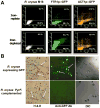The high affinity iron permease is a key virulence factor required for Rhizopus oryzae pathogenesis
- PMID: 20545847
- PMCID: PMC2909342
- DOI: 10.1111/j.1365-2958.2010.07234.x
The high affinity iron permease is a key virulence factor required for Rhizopus oryzae pathogenesis
Abstract
Rhizopus oryzae is the most common cause of mucormycosis, an angioinvasive fungal infection that causes more then 50% mortality rate despite first-line therapy. Clinical and animal model data clearly demonstrate that the presence of elevated available serum iron predisposes the host to mucormycosis. The high affinity iron permease gene (FTR1) is required for R. oryzae iron transport in iron-depleted environments. Here we demonstrate that FTR1 is required for full virulence of R. oryzae in mice. We show that FTR1 is expressed during infection in diabetic ketoacidosis (DKA) mice. In addition, we disrupted FTR1 by double cross-over homologous recombination, but multinucleated R. oryzae could not be forced to segregate to a homokaryotic null allele. Nevertheless, a reduction of the relative copy number of FTR1 and inhibition of FTR1 expression by RNAi compromised the ability of R. oryzae to acquire iron in vitro and reduced its virulence in DKA mice. Importantly, passive immunization with anti-Ftr1p immune sera protected DKA mice from infection with R. oryzae. Thus, FTR1 is a virulence factor for R. oryzae, and anti-Ftr1p passive immunotherapy deserves further evaluation as a strategy to improve outcomes of deadly mucormycosis.
Conflict of interest statement
The authors have no conflict of interest to declare.
Figures







Similar articles
-
Pathogenesis of mucormycosis.Clin Infect Dis. 2012 Feb;54 Suppl 1(Suppl 1):S16-22. doi: 10.1093/cid/cir865. Clin Infect Dis. 2012. PMID: 22247441 Free PMC article. Review.
-
Cloning and functional characterization of the Rhizopus oryzae high affinity iron permease (rFTR1) gene.FEMS Microbiol Lett. 2004 Jun 1;235(1):169-76. doi: 10.1016/j.femsle.2004.04.031. FEMS Microbiol Lett. 2004. PMID: 15158278
-
Fob1 and Fob2 Proteins Are Virulence Determinants of Rhizopus oryzae via Facilitating Iron Uptake from Ferrioxamine.PLoS Pathog. 2015 May 14;11(5):e1004842. doi: 10.1371/journal.ppat.1004842. eCollection 2015 May. PLoS Pathog. 2015. PMID: 25974051 Free PMC article.
-
Iron starvation induces apoptosis in Rhizopus oryzae in vitro.Virulence. 2015;6(2):121-6. doi: 10.1080/21505594.2015.1009732. Virulence. 2015. PMID: 25830548 Free PMC article.
-
Host cell invasion in mucormycosis: role of iron.Curr Opin Microbiol. 2011 Aug;14(4):406-11. doi: 10.1016/j.mib.2011.07.004. Epub 2011 Jul 30. Curr Opin Microbiol. 2011. PMID: 21807554 Free PMC article. Review.
Cited by
-
Pathogenesis of mucormycosis.Clin Infect Dis. 2012 Feb;54 Suppl 1(Suppl 1):S16-22. doi: 10.1093/cid/cir865. Clin Infect Dis. 2012. PMID: 22247441 Free PMC article. Review.
-
Estimation of Serum Ferritin in Mucormycosis Patients and Prognostication Based on the Ferritin Value.Cureus. 2022 Apr 10;14(4):e24013. doi: 10.7759/cureus.24013. eCollection 2022 Apr. Cureus. 2022. PMID: 35547446 Free PMC article.
-
Combination therapy of murine mucormycosis or aspergillosis with iron chelation, polyenes, and echinocandins.Antimicrob Agents Chemother. 2011 Apr;55(4):1768-70. doi: 10.1128/AAC.01577-10. Epub 2011 Jan 24. Antimicrob Agents Chemother. 2011. PMID: 21263057 Free PMC article.
-
Sporangiospore size dimorphism is linked to virulence of Mucor circinelloides.PLoS Pathog. 2011 Jun;7(6):e1002086. doi: 10.1371/journal.ppat.1002086. Epub 2011 Jun 16. PLoS Pathog. 2011. PMID: 21698218 Free PMC article.
-
CRISPR-Cas9 induces point mutation in the mucormycosis fungus Rhizopus delemar.Fungal Genet Biol. 2019 Mar;124:1-7. doi: 10.1016/j.fgb.2018.12.002. Epub 2018 Dec 15. Fungal Genet Biol. 2019. PMID: 30562583 Free PMC article.
References
-
- Artis WM, Fountain JA, Delcher HK, Jones HE. A mechanism of susceptibility to mucormycosis in diabetic ketoacidosis: transferrin and iron availability. Diabetes. 1982;31:1109–1114. - PubMed
-
- Boelaert JR, Van Cutsem J, de Locht M, Schneider YJ, Crichton RR. Deferoxamine augments growth and pathogenicity of Rhizopus, while hydroxypyridinone chelators have no effect. Kidney International. 1994;45:667–671. - PubMed
-
- Boelaert JR, van Roost GF, Vergauwe PL, Verbanck JJ, de Vroey C, Segaert MF. The role of desferrioxamine in dialysis-associated mucormycosis: report of three cases and review of the literature. Clinical Nephrology. 1988;29:261–266. - PubMed
Publication types
MeSH terms
Substances
Grants and funding
LinkOut - more resources
Full Text Sources
Other Literature Sources
Medical

